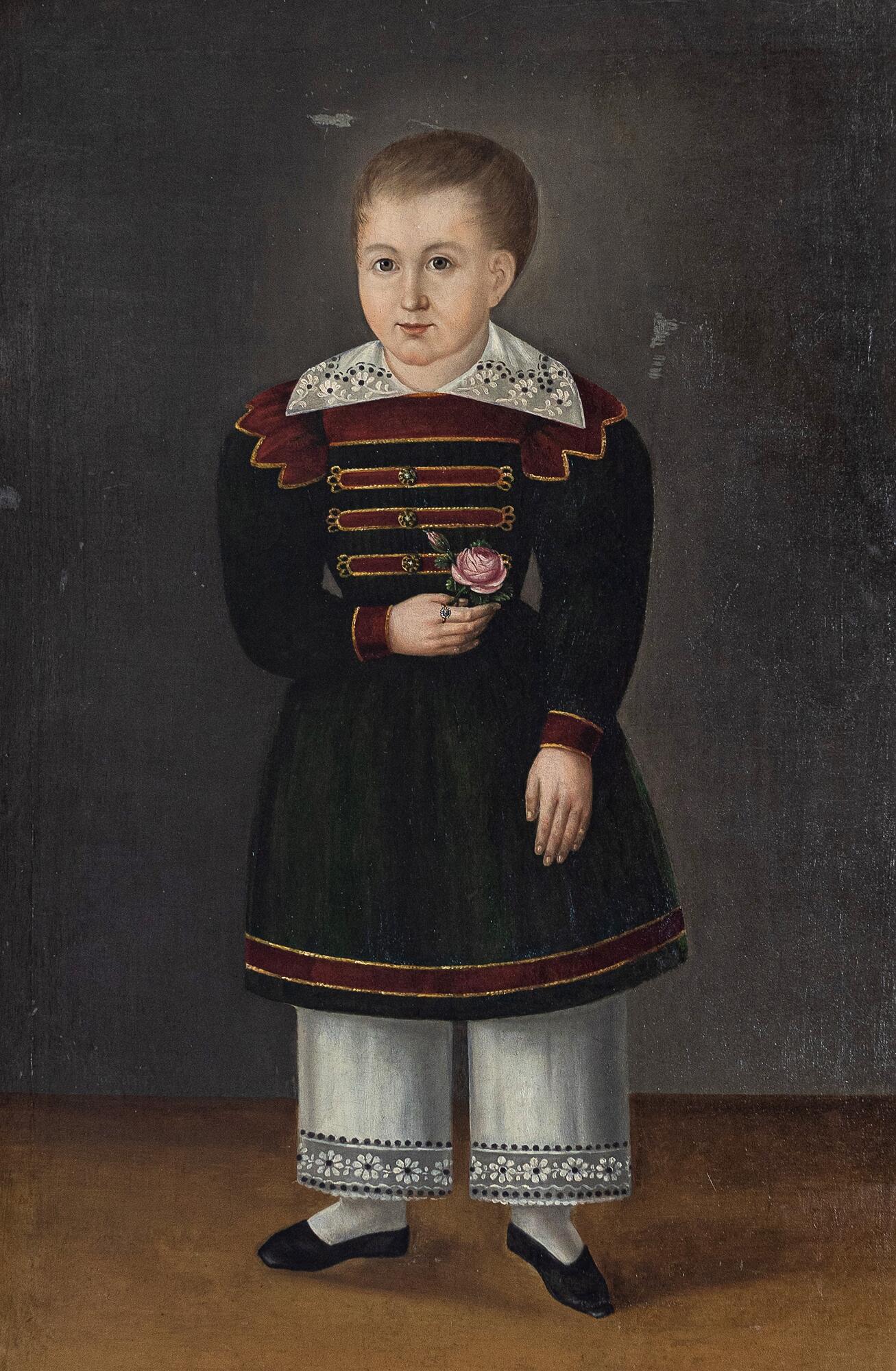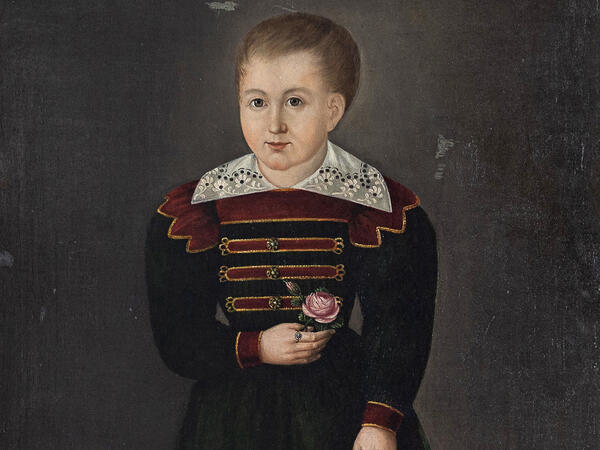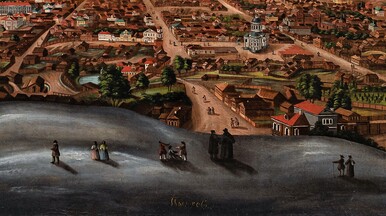The portrait ‘Girl with a Rose’ was painted by an unknown artist in the 19th century. There is also no information concerning either the name of the heroine or where she was from.
The artist depicted the girl in full length. She is dressed in a dark green strict fitted dress, white stockings, and black slippers according to the adult fashion of the 19th century. The dress is decorated with burgundy cuffs and a wide strip with gold piping along the hem of the skirt. A burgundy overlay is attached to the shoulders, forming small decorative flounces. Dull metal buttons are added to the burgundy inserts on the chest. The white lace collar is decorated with embroidered flowers.
The portrait demonstrates the main features of the old painted portrait called parsuna — a flat image and a static pose of the heroine.
The term ‘parsuna’ originated from the distorted Latin word ‘persona’, which means ‘personality’, ‘individual’. This was what this special type of early Russian portrait painting was called in the 17th — early 18th centuries. It became a transition from icon painting to secular portraits.
The authors of many Russian parsunas, especially early ones, remained unknown, but among them were the followers of the large school of painters of the Moscow Kremlin Armory Chamber — Simon Ushakov, Fedor Zubov, Mikhail Choglokov, and other masters.
Russian parsuna was close to the works of Ukrainian, Belorussian, Polish, Lithuanian portrait paintings of the 14th — 17th centuries, which were also often referred to as parsunas. Artists, who painted secular parsunas, did not convey the exact appearance of the portrayed. They often signed works so that it was possible to determine who was depicted on them.
Already in the second half of the 17th century, parsunas were painted on canvases using the technique of oil painting. In the 19th century, the painter of ‘Girl with a Rose’ used oil paints that had already become customary for a parsuna portrait. At the edges and corners of the painting, the paint layer has slightly come off, and a pattern of craquelures is visible on the surface of the artwork. These cracks most often appear from a lack of moisture. The fresh top layer of paint loses water too quickly, as it goes into the insufficiently dried bottom layer, and the image is covered with a network of cracks. In tempera, which was usually used to paint icons and early parsunas, chicken yolk, which is part of the paint, protects against this effect — it gives the paint elasticity, and the oil dries rather slowly.
The artist depicted the girl in full length. She is dressed in a dark green strict fitted dress, white stockings, and black slippers according to the adult fashion of the 19th century. The dress is decorated with burgundy cuffs and a wide strip with gold piping along the hem of the skirt. A burgundy overlay is attached to the shoulders, forming small decorative flounces. Dull metal buttons are added to the burgundy inserts on the chest. The white lace collar is decorated with embroidered flowers.
The portrait demonstrates the main features of the old painted portrait called parsuna — a flat image and a static pose of the heroine.
The term ‘parsuna’ originated from the distorted Latin word ‘persona’, which means ‘personality’, ‘individual’. This was what this special type of early Russian portrait painting was called in the 17th — early 18th centuries. It became a transition from icon painting to secular portraits.
The authors of many Russian parsunas, especially early ones, remained unknown, but among them were the followers of the large school of painters of the Moscow Kremlin Armory Chamber — Simon Ushakov, Fedor Zubov, Mikhail Choglokov, and other masters.
Russian parsuna was close to the works of Ukrainian, Belorussian, Polish, Lithuanian portrait paintings of the 14th — 17th centuries, which were also often referred to as parsunas. Artists, who painted secular parsunas, did not convey the exact appearance of the portrayed. They often signed works so that it was possible to determine who was depicted on them.
Already in the second half of the 17th century, parsunas were painted on canvases using the technique of oil painting. In the 19th century, the painter of ‘Girl with a Rose’ used oil paints that had already become customary for a parsuna portrait. At the edges and corners of the painting, the paint layer has slightly come off, and a pattern of craquelures is visible on the surface of the artwork. These cracks most often appear from a lack of moisture. The fresh top layer of paint loses water too quickly, as it goes into the insufficiently dried bottom layer, and the image is covered with a network of cracks. In tempera, which was usually used to paint icons and early parsunas, chicken yolk, which is part of the paint, protects against this effect — it gives the paint elasticity, and the oil dries rather slowly.



